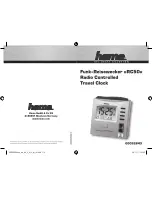
WSN Manual
Page 26 of 34
Rev. G
– 4 March 2007
If a radio is specified as a relay in a link, any locally connected Modbus devices will not be
aware of communications that take place as no activity occurs on the serial port in this state.
This may cause problems however if more than one master exists in a system as a radio that is
being used as a link in a relay is not available to transmit messages.
6.2.3
Power-Save Operation With MODBUS
When Modbus modes are enabled in the configuration programme two further fields appear
entitled “MIN PWR SAVE ADDRESS” and “MAX PWR SAVE ADDRESS”. If power save
operation is not required set both these fields to zero.
If power save operation is required it is enabled by setting the “RADIO ADDRESS” to a value
greater or equal to “MIN PWR SAVE ADDRESS” and less than or equal to “MAX PWR SAVE
ADDRESS”. The radio will then enter low power standby mode for the time programmed in the
“PSAVE ON TIME” field in the main edit menu, it will then wake up and check for an incoming
signal, if none is present it will return to sleep and repeat the cycle. If a signal is detected the
radio will stay awake until a reply to the outward-bound message has been returned.
When the master station or relay radios send an outward bound message, the address of the
radio to which the message is being sent is checked against the min and max power save
addresses, if a power saved radio is indicated a cyclic wake up message is sent for the period
indicated by the programmed power save on time before the actual data message is sent, if a
power saved radio is not indicated the data message is sent immediately. These parameters
along with some others are also used to calculate a timeout time in the event that no reply is
received. It is therefore essential that all radios in a system are programmed with the same
parameters even if not power saved, otherwise communications will fail.
Note that if “DTR SHUTDOWN” is enabled a radio remains completely shut down while DTR is
inactive, it will not wake up according to the power save timer to see if any incoming messages
are present. This mode should therefore only be used in conjunction with real time message
scheduling.
6.2.4
Serial Port Handshaking With MODBUS
When Modbus modes are enabled the DTR and DSR signalling lines can be used to assist in
power saving the host Modbus device. The RTS and CTS lines are not used and the “RTS/CTS
HANDSHAKE” option in the “EDIT MODEM/INTERFACE” menu of the WinA4P programme
should be set to “OFF” in RS232 versions. When the Modbus slave is ready to accept data it
should assert DTR, DSR will be asserted in response and the received message will be output
to the Modbus device. The “HOST INACTIVITY TIME” field in the set up programme defines a
time limit for the Modbus device to assert DTR in response an incoming message and if this
time limit is exceeded the radio sends back a reply indicating the destination device failed to
respond and the link is cancelled. After sending a response, the Modbus slave may then
release DTR and return to power save mode. Note that as long as DTR is asserted the radio will
not return to its power save mode (if enabled in the setup programme). DSR will remain
asserted in this case.
The master station can also control the power saving of its radio using DTR, the radio will
operate in power save mode as long as DTR is not active, asserting DTR wakes the radio,
DSR is asserted in return to indicate that the radio is awake and ready to accept data.
If use of the handshake lines is not required DTR should be connected to a voltage of +3.5 to
+15V such that sleep mode is never allowed.








































